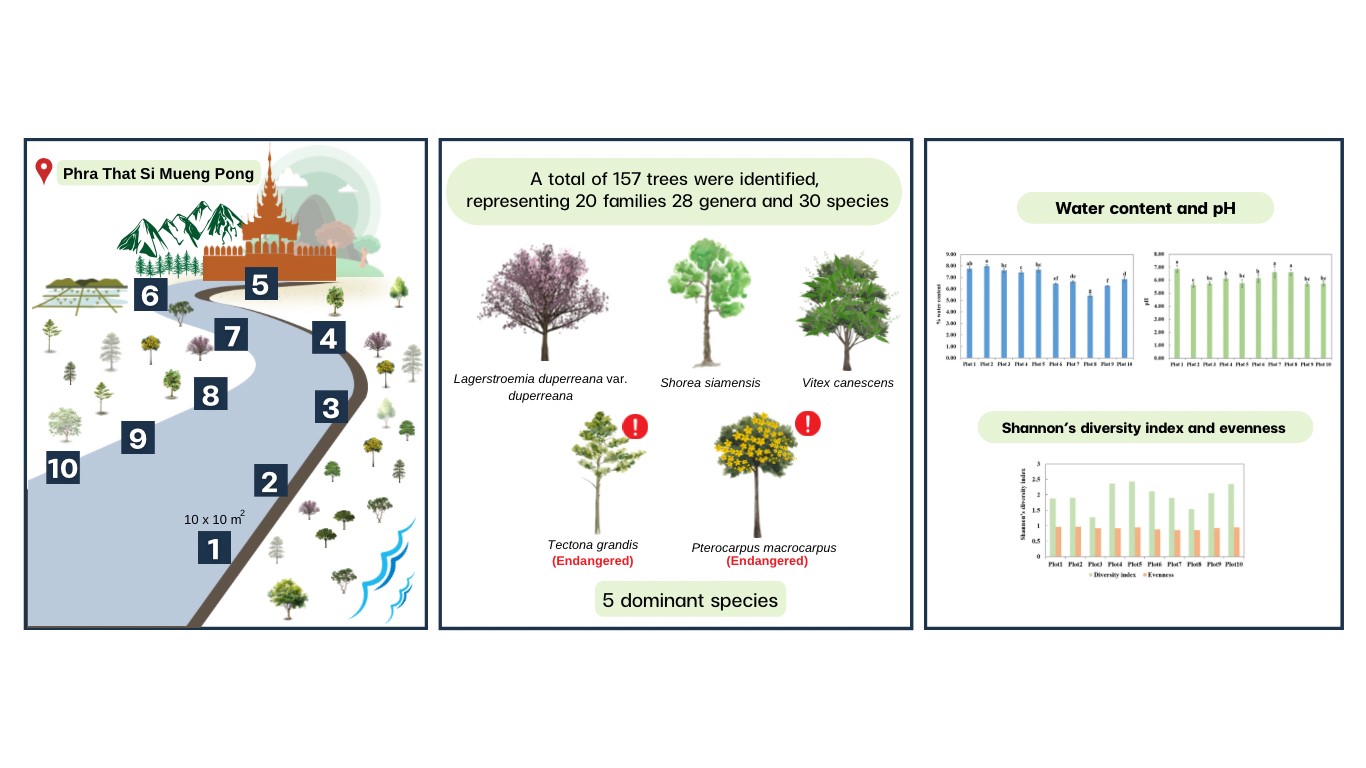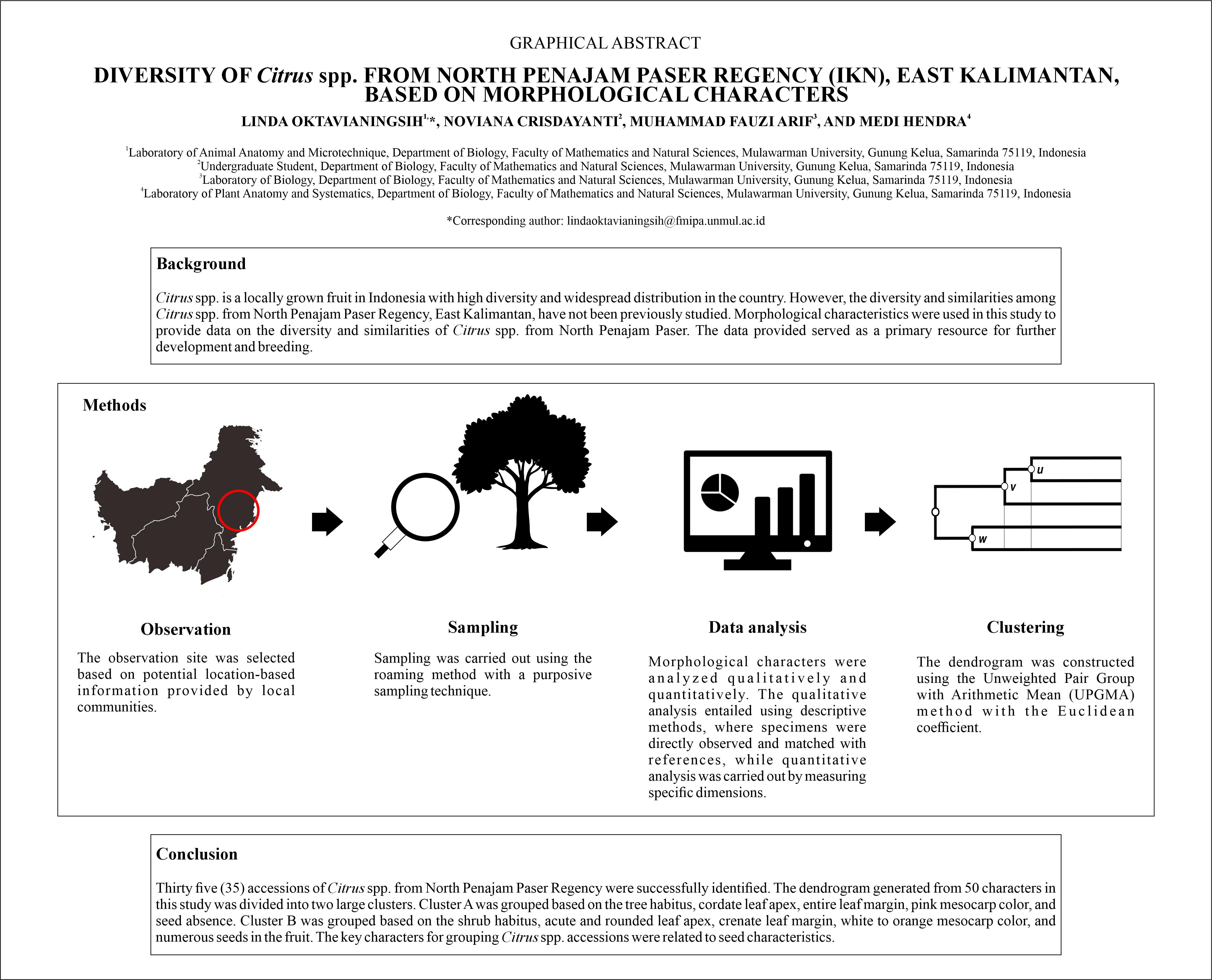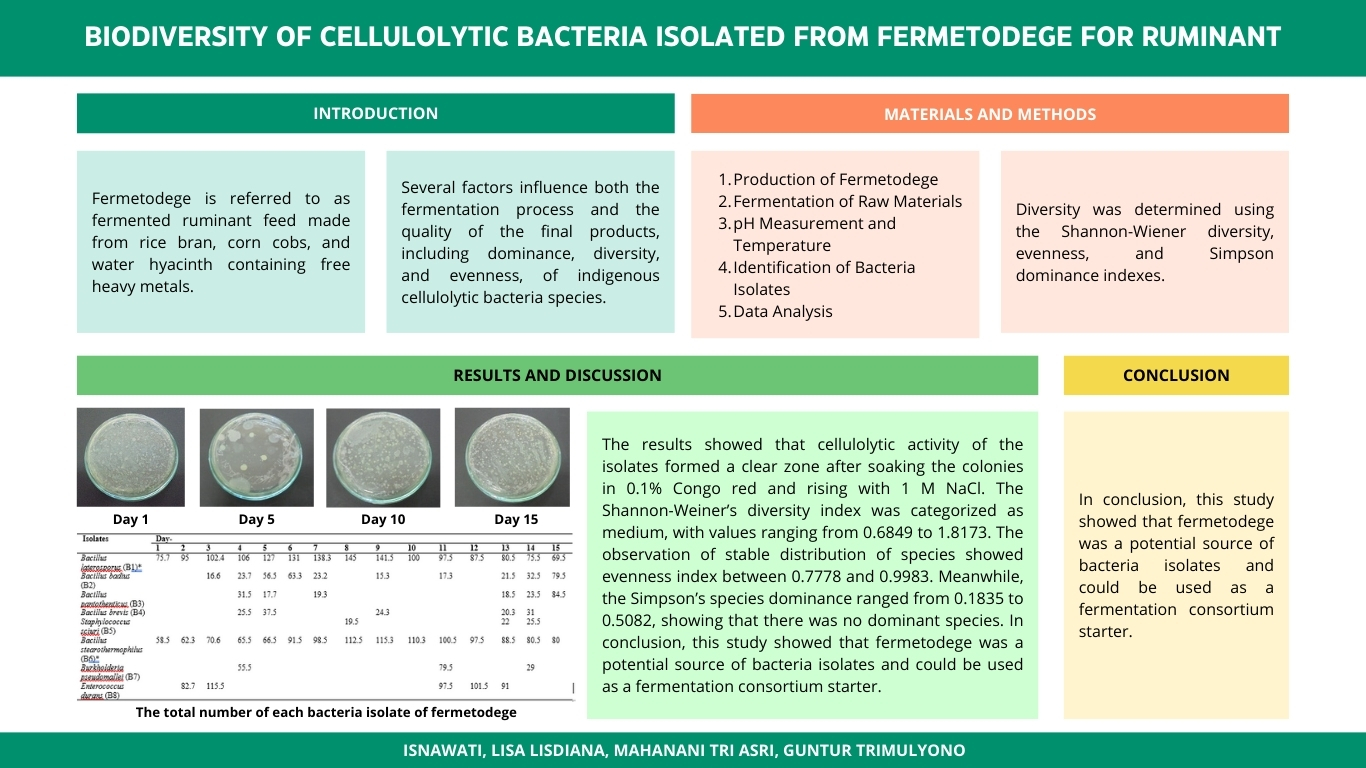IDENTIFICATION OF THE MOLUCCAN MEGAPODE (Eulipoa wallacei) NATURAL HABITAT IN HARUKU ISLAND, INDONESIA AND ITS VEGETATION COMPOSITION
The characteristics of island vegetation greatly influence the activities of endemic birds in island areas, such as the Moluccan endemic megapodes (Eulipoa wallacei) on Haruku Island. Therefore, it is essential to identify the specific location of the habitat utilized by individual birds for their daily activities on Haruku Island and to analyze the composition of the vegetation and the variety of plant species. Identification of bird habitat locations using radio-tracking on four newly hatched chicks and four adult birds. A total of 330 individual tracking points were recorded during the study period. The vegetation sample used a total of 420 plots for seedlings, saplings, poles, and trees which were then analyzed for importance value index (IVI), diversity, evenness, and similarity. We found that the Tanjung Maleo forest was their nesting habitat, while the Marunimei and Lalean forests were their daily habitats. A total of 91 plant species and 60 plant families were discovered with the vegetation diversity value of the three habitats was moderate (H’mean = 3.07) and tended to be dominated by air plant (Kalanchoe pinnata), sword fern (Nephrolepsis exalta), cogongrass (Imperata cylindrica), coco-grass (Cyperus rotundus), Indian camphorweed (Pluchea indica), and lanzone (Lansium domesticum) (Emean = 0.88), and have a relatively low level of species similarity between habitats (SImean = 38.30%). We found that the daily habitat of the Moluccan megapode on Haruku Island was around their nesting sites and has a complex structure because it was composed four vegetation strata. Therefore, for conservation purposes, habitat management must prioritize preserving forest habitats around the bird nesting sites.
Downloads
Ahmad Z. 2014. Selection strategy for laying eggs by mamoa bird (Eulipoa wallacei Gray, 1980) in Galela. Biogenesis 2: 79-88 [in Indonesia]. DOI: https://doi.org/10.24252/bio.v2i2.471
Aldrian E, Dwi Susantio R. 2003. Identification of three dominant rainfall regions within Indonesia and their relationship to sea surface temperature. Internasional. Journal of Climatology 23: 1435-1452. DOI: https://doi.org/10.1002/joc.950
Argeloo M, Dekker RWRJ. 1996. Exploitation of megapode eggs in Indonesia: the role of traditional methods in the conservation of megapodes. Oryx 30(1): 59-64. DOI: https://doi.org/10.1017/S0030605300021396
Atikah SN, Yahya MS, Norhisham AR, Kamarudin N, Sanusi R, Azhar B. 2021. Effects of vegetation structure on avian biodiversity in a selectively logged hill dipterocarp forest. Gobal Ecology and Conservation 28:e01660. DOI: 10.1016/ j.gecco.2021.e01660. DOI: https://doi.org/10.1016/j.gecco.2021.e01660
Badan Pusat Statistik Propinsi Maluku. 2022. Maluku Province in Figures 2022. Ambon (IN): Badan Pusat Statistik (BPS) Propinsi Maluku.
Baldeck CA, Harms KE, Yavitt JB, John R, Turner BL, Valencia R, Navarrete H, Davies SJ, Chuyong GB, Kenfack D, Thomas DW, Madawala S, Gunatilleke N, Gunatilleke S, Bunyavejchewin S, Kiratiprayoon S, Yaacob A, Supardi MNN, Dalling JW. 2012. Soil resources and topography shape local tree community structure in tropical forests. Proceedings of the Royal Society B. Biological Sciences 280: 2012-2532. DOI: https://doi.org/10.1098/rspb.2012.2532
Barbour MG, Burk JH, Pitts WD. 1987. Terrestrial Plant Ecology. New York (US): Benyamin Cummings Publishing Company.
Bendre AM, Kumar A. 2010. A Textbook of Practical Botany II: Taxonomy, Economic Botany, Embryology, Anatomy, Ecology, Physiology, Biostatistics, Cytology, and Genetics. New Delhi (IN): Rastogi Publications.
Bergner A, Mustafa A, Hasan E, Nicklas J, Mats N, Westerberg L, Milberg P. 2015. Influences of forest type and habitat structure on bird assemblagesof oak (Quercus spp.) and pine (Pinus spp.) stands in southwestern Turkey. Forest Ecology and Management 336:137–147. DOI: 10.1016/j.foreco.2014.10.025. DOI: https://doi.org/10.1016/j.foreco.2014.10.025
BirdLife International. 2016. Eulipoa wallacei. The IUCN Red List of Threatened Species 2016: e.T22678632A92782396. http://dx.doi.org/10.2305/IUCN. UK. 2016-3.RLTS.T22678632-A92782396.en
BirdLife International. 2022. Species factsheet: Eulipoa wallacei. Downloaded from http://www.birdlife.org on 06 Juli 2022.
Bloom PH, Clark WS, Kidd JW. 2007. Capture techniques. In: Bird DM, Bildstein KL, Barber DR, Zimmerman A, editors. Raptor Research and Management Techniques. Blaine (US): Hankock House Publishers. p. 193-219
Bosch R, Real J, Tinto A, Zozaya EL, Castell C. 2010. Home-range and patterns of spatial use in territorial Bonelli’s eagles Aquila fasciata. Ibis 152: 105-117. DOI: https://doi.org/10.1111/j.1474-919X.2009.00985.x
Bowman J, Wallace MC, Ballard WB, Brunjes IV JH, Miller MS, Marquette-Hellman J. 2002. Evaluation of two techniques for attaching radio transmitters to turkey poults. J Field Ornithol 73(3): 276-280. DOI: https://doi.org/10.1648/0273-8570-73.3.276
Bu W, Zang R, Ding Y. 2014. Functional diversity increases with species diversity along successional gradient in a secondary tropical lowland rainforest. Tropical Ecology 55:393–401. DOI: https://doi.org/10.1016/j.actao.2013.10.002
Bucklin DN, Basille M, Benscoter AM, Brandt LA, Mazzotti FJ, Romanach SS, Speroterra C, Watling JI. 2015. Comparing species distribution models constructed with different subsets of evironmental predictors. Diversity and Distributions 21: 23-35. DOI: https://doi.org/10.1111/ddi.12247
Busse P, Meissner W. 2015. Bird ringing station manual. Warsaw (PL): De Gruyter Open Ltd. DOI: https://doi.org/10.2478/9788376560533
Collar NJ, Crosby MJ, Stattersfield AJ. 1994. Birds to watch 2. The world list of threatened birds. BirdLife Conservation Series No. 4. Cambridge (UK): BirdLife International.
Colwell RK. 2009. Biodiversity: concepts, patterns, and measurement. In: Levin SA, Carpenter SR, Godfray HCJ, Kinzig AP, Loreau M, Losos JB, Wilcove DS, editors. The Princeton Guide to Ecology. New Jersey (US): Princeton University Press. p. 257-263.
De Beer SJ, Lockwood GM, Raijmakers JHFA, Raijmakers JMH, Scott WA, Oschadleus HD, Underhill LG. 2001. Safring Bird Ringing Manual. ADU Guide 5. The South African Bird Ringing Unit – Avian Demography Unit. Rondebosch (ZA): University of Cape Town.
Dekker RWRJ, Fuller RA, Baker GC. 2020. Megapodes: status survey and conservation action plan 2000–2004. WPA/BirdLife/SSC Megapode Specialist Group. Gland (CH): IUCN and Reading: the World Pheasant Association.
Dekker RWRJ, Argeloo M, Jepson P. 1995. Notes on the Moluccan megapode Eulipoa wallacei (G.R. Gray, 1860) following the rediscovery of two major nesting grounds. Zoologische Mededelingen 69(19): 251-260.
del Hoyo J, Elliott A, Sargatal J. 1994. Handbook of birds of the world, Volume 2, New World vultures to guineafowl. Barcelona (ES): Lynx Edicions.
Devenish-Nelson ES, Weidemann D, Townsend J, Nelson HP. 2019. Pattern in island endemic forest-dependent bird research: the Caribbean as a case study. Biodiversity and Conservation 28: 1885-1904. DOI: 10.1007/s10531-019-01768-x. DOI: https://doi.org/10.1007/s10531-019-01768-x
Dhafir F, Bustamin, Isnainar, Trianto M. 2022. Maleo bird laying behavior (Macrocephalon maleo S. Muller) at Lore Lindu National Park, Saluki Blok. Media Eksakta 18(1): 74-80. DOI: 10.22487/ me.v18i1.1712. DOI: https://doi.org/10.22487/me.v18i1.1712
Diemer KM, Wheeler HE, Nocera JJ. 2014. Retention rates of glue-attached radio-transmitters on two small bird species with contrasting life histories. The Wilson Journal of Ornithology 126(1): 39-46. DOI: https://doi.org/10.1676/13-098.1
Dri GF, Fontana CS, de Sales Dambros C. 2021. Estimating the impacts of habitat loss induced by urbanization on bird local extinctions. Biological Conservation 256:109064. Doi: 10.1016/ j.biocon.2021.109064. DOI: https://doi.org/10.1016/j.biocon.2021.109064
Duncan RP, Blackburn TM. 2007. Causes of extinction in island birds. Animal Conservation 10: 149-150. DOI: https://doi.org/10.1111/j.1469-1795.2007.00110.x
Feng G, Huang X, Mao L, Wang N, Yang X, Wang Y. 2020. More endemic birds occur in regions with stable climate, more plant species and high altitudinal range in China. Avian Research 11: 7. DOI: 10.1186/s40657-020-00203-y. DOI: https://doi.org/10.1186/s40657-020-00203-y
Gao T, Hedblom M, Emilsson T, Nielsen AB. 2014. The role of forest stand structure as a biodiversity indicator. Forest Ecology and Management, 330: 82-93. DOI: 10.106/j.foresco. 2014.07.007 DOI: https://doi.org/10.1016/j.foreco.2014.07.007
Goth A, Evans CS. 2005. Life history and social learning: megapode chicks fail to acquire feeding preference from conspecifics. Journal of Comparative Psychology 119(4): 281-386. DOI: https://doi.org/10.1037/0735-7036.119.4.381
Goth A, Jones DN. 2001. Transmitter attachment and its effects on Australian brush turkey hatchlings. Wildlife Research 28(1): 73-78. DOI: https://doi.org/10.1071/WR99111
Goth A, Vogel U. 1995. Status of the Polynesian Megapodius pritchardii on Niuafo’ou (Tonga). Bird Conservation International 5: 117-128. DOI: https://doi.org/10.1017/S0959270900002975
Goth A, Vogel U. 2002. Social behaviour of two free-ranging chicks of Australian brush-turkey Alectura lathami. Corella 26(2): 55-58.
Goth A, Vogel U. 2003. Juvenile dispersal and habitat selectivity in the megapode Alectura lathami (Australian brush turkey). Wildlife Research 30(1): 69-74. DOI: https://doi.org/10.1071/WR01053
Gunawan H, Sugiarti, Wardani M, Mindawati N. 2019. 100 species pohon nusantara target konservasi ex-situ taman keanekaragaman hayati. Bogor: IPB Press.
Heij CJ, Rompas CFE. 2011. Ecology of Moluccan megapode (Momoa bird: Eulipoa wallacei) on Haruku Island and other island in Maluku, Indonesia. 3rd Ed. Rotterdam (NL): Meidoornsingel.
Heij CJ. 2001. On the earliest written descriptions of Moluccan megapode Eulipoa wallacei and its peculiar nesting behaviour. Deinsea 8: 253-255.
Heij CJ, Rompas CFE, Moeliker CW. 1997. The biology of the Moluccan megapode Eulipoa wallacei (Aves, Galliformes, Megapodiidae) on Haruku and other Moluccan islands Part 2: Final report. Deinsea 3: 1-124.
Jones D, Dekker R, Roselar C. 1995. The megapodes. New York (US): Oxford University Press Inc.
Khairudin K, Yamin M. 2019. Megapodius reinwardt conservation based on ecological knowledge of local people to support sustainable ecotourism on Moyo Island. AIP Conference Proceedings 2199:050004. DOI: 10.1063/1.5141302 DOI: https://doi.org/10.1063/1.5141302
Krebs CJ. 1998. Ecological methodology. 2nd Edition. New York (US): Benjamin Cummings.
Kusmana C. 2017. Metode survey dan interpretasi data vegetasi. Bogor (ID): IPB Press.
Llamas KA. 2003. Tropical flowering plants: a guide to identification and cultivation. Portland (US): Timber Press Inc.
Lemmens RHMJ, Soerianegara I, Wong WC. 1995. Plant resources of South-East Asia, No. 5(2) Timber Trees: Minor Commercial Timbers. Bogor: Prosea Foundations
MacKinnon J, Wind J. 1980. Birds of Indonesia. Rome (IT): Food and Agriculture of the United Nation.
Matthews TJ, Cottee-Jones HEW, Whittaker RJ. 2015. Quantifying and interpreting nestedness in habitat islands: a synthesis analysis of multiple data- sets. Diversity and Distribution 21: 392-404. DOI: 10.1111/ddi.12298. DOI: https://doi.org/10.1111/ddi.12298
Melo MA, Da Silva MAG, Piratelli AJ. 2020. Improvement of vegetation structure enhances bird functional traits and habitat resilience in an area of ongoing restoration in the Atlantic Forest. An Acad. Bras. Cienc 92(Suppl 2):e20191241. DOI: https://doi.org/10.1590/0001-3765202020191241
Moudry V, Moudra L, Bartak V, Bejcek V, Gdulova K, Hendrychova M, Moravec D, Musil P, Rocchini D, Stastny K, Volf O, Salek M. 2021. The role of the vegetation structure, primary productivity, and senescence derived from airborne LiDAR and hyperspectral data for bird's diversity and rarity on a restored site. Landscape and Urban Planning 210: 104064. DOI: 10.1016/ j.landurbplan.2021.104064 DOI: https://doi.org/10.1016/j.landurbplan.2021.104064
National Standardization Agency of Indonesia. 2010. Land Cover Classification. Indonesian National Standart (SNI). No. 7645. Jakarta
Odum EP. 1983. Basic Ecology. Philadelphia (US): Saunders College.
Paguntalan LJ, Oquendo MFJM, Bonares BA, Villegas GM. 2021. Ecology of Philippine scrubfowl Megapodius cumingii on Palwan with notes on other islands. Journal of Asian Ornithology 37: 99-106.
Pangau-Adam MZ, Brodie JF. 2019. Threats to the populations of two endemic brushturkey species in Indonesian New Guinea. Journal of Asia-Pasific Biodiversity 12: 488-492. DOI: 10.1016/j/ japb.2019.07.005 DOI: https://doi.org/10.1016/j.japb.2019.07.005
Peng Y, Fan M, Song J, Cui T, Li R. 2018. Assessment of plant species diversity based on hyperspectral indices at fine scale. Scientific Report 8: 4776. DOI: 10.1038/s41598-018-23136-5. DOI: https://doi.org/10.1038/s41598-018-23136-5
Radley PM, van Etten EJB, Blake S, Davis R.A. 2020. Breeding and feeding habitat selection by an island endemic bird may increase its vulnerability to climate change. Biotropica 00: 1-11. DOI: 10.1111/btp.12885 DOI: https://doi.org/10.1111/btp.12885
Rahman AU, Khan SM, Khan S, Hussain A, Rahman IU, Iqbal Z, Ijaz F. 2016. Ecological assessment of plant communities and associated edaphic and topographic variables in the Peochar Valley of the Hindu Kush Mountains. Mountain Research and Development 36(3): 332-341. DOI: https://doi.org/10.1659/MRD-JOURNAL-D-14-00100.1
Rechetelo J, Grice A, Reside AE, Hardesty BD, Moloney J. 2016. Movement patterns, home range and habitat selection of an endangered resource tracking species, the black throated finch (Poephila cincta cincta). PLoS ONE 11:20167254. DOI: org/10.1371/journal.pone.0167254. DOI: https://doi.org/10.1371/journal.pone.0167254
Rocha R, Virtanen T, Cabeza M. 2015. Bird assemblages in Malagasy forest-agriculture frontier: effects of habitat structure and forest cover. Tropical Conservation Science 8(3): 681-710 DOI: https://doi.org/10.1177/194008291500800307
Ruiz-Gutierrez V, Gain TA, Dhondt A. 2008. Habitat fragmentation lowers survival of a tropical forest bird. Ecological Applications 18(4): 838-846. DOI: https://doi.org/10.1890/07-1090.1
Rutten G, Ensslin A, Hemp A, Fischer M. 2015. Vertical and horizontal vegetation structure across natural and modified habitat types at Mount Kilimanjaro. PLoS ONE 10(9):e0138822. Doi: 10.1371/ journal.pone.0138822. DOI: https://doi.org/10.1371/journal.pone.0138822
Ryan CJ, Jamieson IG. 1998. Estimating the home range and carrying capacity for Takahe (Porphyrion mantelli) on predator-free offshore islands: implications for future management, New Zealand Journal of Ecology 22(1): 17-24.
Shannon CE, Weaver W. 1963. The mathematical theory of communication. Urbana. Illinois (US): University of Illinois Press.
Sjafani N, Hakim L, Nurgiartiningsih VMA, Suyadi R. 2015. The habitat and estimation population of mamoa bird (Eulipoa wallacei) in Galela-Halmahera. Journal of Biodiversity and Environmental Science 7(2): 1-9.
Sodhi NS, Sekercioglu CH, Barlow J, Robinson SK. 2011. The state of tropical bird biodiversity. In: Sodhi NS, Sekercioglu CH, Barlow J, Robinson SK, editors. Conservation of Tropical Birds. First Edition. Lichester (UK): Willey-Blackwell Publishing Ltd. p. 1-26. DOI: https://doi.org/10.1002/9781444342611
Soerianegara I, Lemmens RHMJ. 1994. Plant resources of South-East Asia, No. 5(1) Timber Trees: Major Commercial Timbers. Bogor: Prosea Foundations
Sorensen T. 1948. A method of establishing roups of equal amplitude in plant sociology based on similarity of species and its application to analyses of the vegetation on Danish commons. Kongelige Danske Videnskabernes Selskab 5(4): 1-34.
Strange M. 2012. A photographic guide to the birds of Indonesia. 2nd Edition. Singapore (SG): Tuttle Publishing.
Starck JM, Ricklefs RE. 1998. Pattern of development: the altricial- precocial spectrum. In: Starck JM, Ricklefs RE, editors. Avian Growth and Development: Evolution Within the Altricial Precocial Spectrum. New York (US): Oxford University Press. p. 3-30.
Tassicker AL, Kutt AS, Vanderduys E, Mangru S. 2006. The effects of vegetation structure on the birds in a tropical savanna woodland in north-eastern Australia. The Rangeland Journal 28: 139-152. DOI: https://doi.org/10.1071/RJ05029
Taylor S, Kumar L. 2016. Global climate change impacts on Pacific Islands terrestrial biodiversity: a review. Tropical Conservation Science 9: 203-223. DOI: https://doi.org/10.1177/194008291600900111
Tchoumnbou MA, Malange EFN, Tiku CT, Tibab B, Fru-Cho J, Tchuinkam T, Awah-Ndukum J, Nota DA, Sehgal RNM. 2020. Response of understory bird feeding groups to deforestation gradient in a tropical rainforest of Cameroon. Tropical Conservation Science. 13: 1-12. DOI: 10.1177/ 1940082920906970. DOI: https://doi.org/10.1177/1940082920906970
Tews J, Brose U, Grimm V, Tielborger K, Wichmann MC, Schwager M, Jeltsch F. 2004. Animal species diversity is driven by habitat heterogeneity/diversity: the importance of keystone structures. Journal of Biogeography 31(1): 79-92. DOI: 10.1046/j.0305-0270.2003.00994.x. DOI: https://doi.org/10.1046/j.0305-0270.2003.00994.x
Tulloch AIT, Barnes MD, Ringma J, Fuller AR, Waston JEM. 2016. Understanding the importance of small patches of habitat for conservation. J Appl Ecol 53: 418-429. DOI: https://doi.org/10.1111/1365-2664.12547
Velásquez-Trujillo V, Betancurt-Grisales JF, Vargas-Daza AM, Lara CE, Rivera-Páez FA, Fonturbel FE, Castaño-Villa GJ. 2021. Bird Functional Diversity in Agroecosystems and Secondary Forests of the Tropical Andes. Diversity 13:493. DOI: 10.3390/d13100493. DOI: https://doi.org/10.3390/d13100493
Walther BA, Pirsig LH. 2017. Determining conservation priority areas for palearctic passerine migrant birds in sub-Saharan Africa. Avian Conservation and Ecology 12(1): 2. DOI:10.5751/ACE-00934-120102. DOI: https://doi.org/10.5751/ACE-00934-120102
Whitmore T. C. 1978. Tree flora of Malaya: a manual for foresters. Volume 3. Malaysia: Longman Malaysia SDN.
Whitworth D, Newman S, Mundkur T, Harris P. 2007. Bird handling and ringing techniques. In: Whitworth D, Newman SH, Mundkur T, Harris P, editors. Wild Birds and Avian Influenza: An Introduction to Applied Field Research and Disease Sampling Techniques. Rome (IT): Food and Agricultural Organization of the United Nation. p. 51-72.
Wirjohamidjojo S, Swarinoto Y. 2010. Indonesian Climate (Dynamics and Synoptic), Indonesian Meteorology. Jakarta (ID): Climatology and Geophysical Agency.
Woodward A, Hutten KM, Boetsch JR, Acker SA, Rochefort RM, Bivin MM, Kuth LL. 2009. Forest Vegetation Monitoring Protocol for National Parks in The North Coast and Cascades Network: U.S. Geological Survey Techniques and Methods 2-A8, U.S. Geological Survey, Reston. DOI: https://doi.org/10.3133/tm2A8
Yaremych SA, Novak RJ, Raim AJ, Mankin PC, Warner RE. 2004. Home range and habitat use by American crows in relation to transmission of West Nile virus. Wilson Bulletin 116(3): 232-239. DOI: https://doi.org/10.1676/03-104
Yuni LPEK, Yuda IP. 2020. The Island Biogeography of Wallacea and Krakatoa Island. In: Goldstein MI, DellaSala DA, editors. Encyclopedia of the World’s Biomes. Volume 1. London (UK): Elsevier. p. 217-229. DOI: https://doi.org/10.1016/B978-0-12-409548-9.11789-0
Copyright (c) 2023 Handy Erwin Pier Leimena, Achmad Sjarmidi, Tati Suryati Syamsudin

This work is licensed under a Creative Commons Attribution-NonCommercial-NoDerivatives 4.0 International License.
Authors who publish with this journal agree with the following terms:
- Authors retain copyright and grant the journal right of first publication, with the work 1 year after publication simultaneously licensed under a Creative Commons attribution-noncommerical-noderivates 4.0 International License that allows others to share, copy and redistribute the work in any medium or format, but only where the use is for non-commercial purposes and an acknowledgement of the work's authorship and initial publication in this journal is mentioned.
- Authors are able to enter into separate, additional contractual arrangements for the non-exclusive distribution of the journal's published version of the work (e.g., post it to an institutional repository or publish it in a book), with an acknowledgement of its initial publication in this journal.
- Authors are permitted and encouraged to post their work online (e.g., in institutional repositories or on their website) prior to and during the submission process, as it can lead to productive exchanges, as well as earlier and greater citation of published work (See The Effect of Open Access).






























